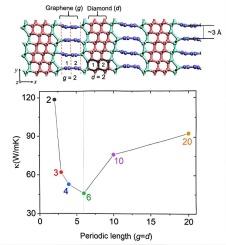金刚石-石墨烯超晶格中的声子热输运
IF 5.1
3区 材料科学
Q2 MATERIALS SCIENCE, COATINGS & FILMS
引用次数: 0
摘要
金刚石-石墨烯超晶格是通过强共价键周期性地组装金刚石和石墨烯畴而构建的,由于其具有整合两种材料的优异性能的潜力而引起了越来越多的关注。虽然金刚石和石墨烯各自表现出超高的导热性,但它们共价键超晶格结构的声子传输特性仍然知之甚少,特别是关于强sp2-sp3界面的作用。这种理解的缺乏阻碍了碳基复合材料的合理设计,以实现有效的热管理。在这项研究中,我们采用非平衡分子动力学模拟系统地研究了金刚石-石墨烯超晶格中声子介导的热输运。结果表明,由于碳-碳键强,原子质量低,其界面热导率达到6.33 × 109 W/m2K,显著高于其他共价键异质结构。此外,热导率表现出明显的非单调依赖于周期长度,反映了从相干到非相干声子输运体制的转变:它在相干阈值以下降低,超过相干阈值后增加。在200 ~ 600 K的温度范围内,相干周期最小值没有发生偏移,表明在该温度范围内相干-非相干交叉是稳健的。这些发现解决了理解共价键合碳超晶格中热传导的关键知识缺口。他们提供了声子相干和界面输运机制的基本见解,为设计先进的热界面材料和下一代纳米电子器件提供了有价值的指导,其中高效散热是必不可少的。本文章由计算机程序翻译,如有差异,请以英文原文为准。

Phonon thermal transport in diamond-graphene superlattices
Diamond-graphene superlattices, constructed by periodically assembling diamond and graphene domains via strong covalent bonds, have attracted increasing attention due to their potential to integrate the outstanding properties of both materials. While diamond and graphene individually exhibit ultrahigh thermal conductivity, the phonon transport characteristics of their covalently bonded superlattice structures remain poorly understood, especially regarding the role of strong sp2-sp3 interfaces. This lack of understanding hampers the rational design of carbon-based composites for efficient thermal management.
In this study, we employ non-equilibrium molecular dynamics simulations to systematically investigate phonon-mediated thermal transport in diamond-graphene superlattices. We demonstrate that the interfacial thermal conductance reaches 6.33 × 109 W/m2K, a value significantly higher than most other covalently bonded heterostructures, owing to strong carbon–carbon bonding and low atomic mass. Moreover, the thermal conductivity exhibits a distinct non-monotonic dependence on periodic length, reflecting a transition from coherent to incoherent phonon transport regimes: it decreases below a coherence threshold and increases beyond it. Temperature variation from 200 to 600 K does not shift the coherence-period minimum, indicating that the coherence–incoherence crossover is robust within this temperature range.
These findings address a key knowledge gap in understanding heat conduction in covalently bonded carbon superlattices. They provide fundamental insights into the mechanisms of phonon coherence and interfacial transport, offering valuable guidance for the design of advanced thermal interface materials and next-generation nanoelectronic devices where efficient heat dissipation is essential.
求助全文
通过发布文献求助,成功后即可免费获取论文全文。
去求助
来源期刊

Diamond and Related Materials
工程技术-材料科学:综合
CiteScore
6.00
自引率
14.60%
发文量
702
审稿时长
2.1 months
期刊介绍:
DRM is a leading international journal that publishes new fundamental and applied research on all forms of diamond, the integration of diamond with other advanced materials and development of technologies exploiting diamond. The synthesis, characterization and processing of single crystal diamond, polycrystalline films, nanodiamond powders and heterostructures with other advanced materials are encouraged topics for technical and review articles. In addition to diamond, the journal publishes manuscripts on the synthesis, characterization and application of other related materials including diamond-like carbons, carbon nanotubes, graphene, and boron and carbon nitrides. Articles are sought on the chemical functionalization of diamond and related materials as well as their use in electrochemistry, energy storage and conversion, chemical and biological sensing, imaging, thermal management, photonic and quantum applications, electron emission and electronic devices.
The International Conference on Diamond and Carbon Materials has evolved into the largest and most well attended forum in the field of diamond, providing a forum to showcase the latest results in the science and technology of diamond and other carbon materials such as carbon nanotubes, graphene, and diamond-like carbon. Run annually in association with Diamond and Related Materials the conference provides junior and established researchers the opportunity to exchange the latest results ranging from fundamental physical and chemical concepts to applied research focusing on the next generation carbon-based devices.
 求助内容:
求助内容: 应助结果提醒方式:
应助结果提醒方式:


